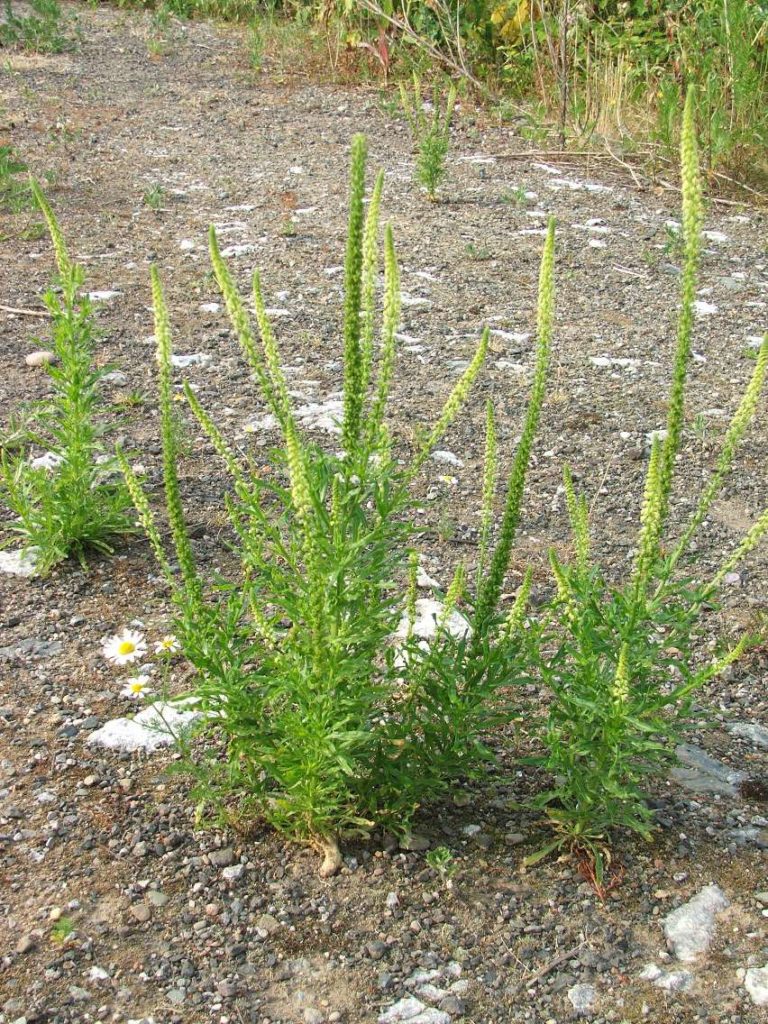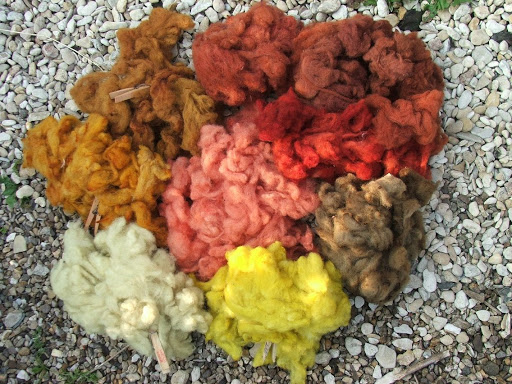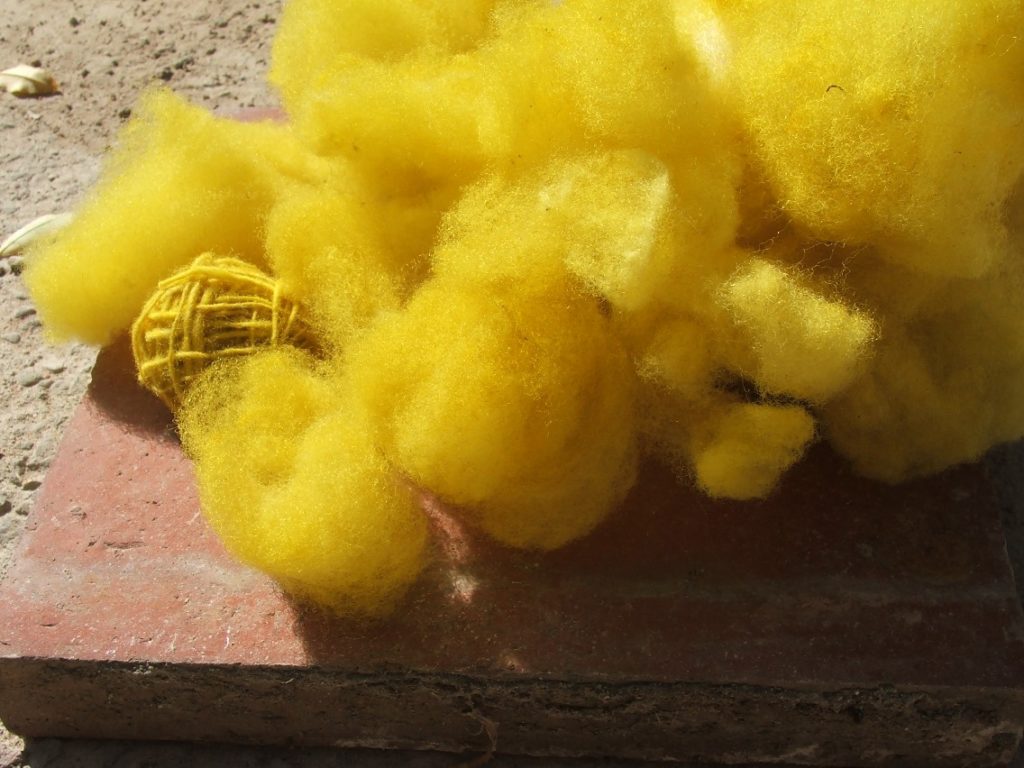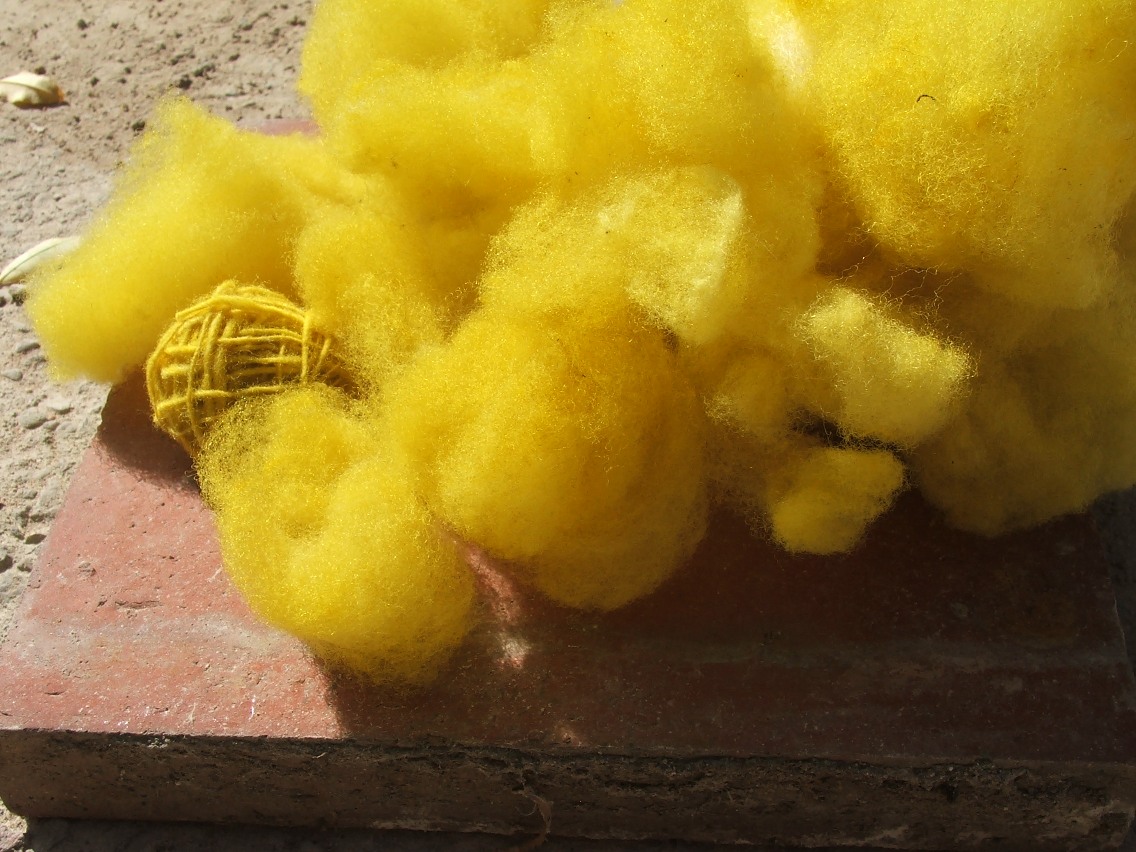Last year I collected some dyers rocket or weld (Reseda luteola) that was growing locally, in abundance, on waste ground just off a cycle path I know. It stopped me in my tracks. ‘That looks familiar’, I thought. The spike-like flowers, growing out of a rosette of slim, spear-shaped leaves were distinctive. They were growing as far as I could see, towards a path along the River Severn. The arc of the new Diglis foot and cycle bridge rose up from a ramp off the path. This was where I was heading, as it was a sunny day – so I’d set off on bike ride.
The weedy waste ground drew my attention though, so I’d stopped for a wander around. I fumbled for my phone and googled ‘Dyer’s Rocket’. There it was: the dye plant I recognised, which people have used to dye cloth yellow for thousands of years. It was looking fresh and ripe for the picking, and so handy too. This seemed like providence, that I should trip over it here. It was an invitation to continue my dyeing endeavours which I started last summer. Last year, I drove west into Wales, one weekend, to take part in a workshop on natural plant dyeing. Jane Meredith of Plant Dyed Wool was the tutor and Old Chapel Farm near Llandinloes, the host.

Out of the Petri Dish
Tiny, pale yellow seeds floated in water in a petri dish under my microscope. It always provokes a smile when they do. A plump disc, with a pinch in the middle on one side, like a navel; they’re quite distinctive. Dyer’s rocket, or weld, shed these tiny seeds several centuries ago. It’s usually a sign that someone nearby was growing this yellow dye plant. At some time at least, as even if these seeds came from plants that escaped from cultivation – someone originally cultivated them. They’re usually found in waterlogged ground. So if near a stream or river, they may have washed in from further upstream. Then, my job as interpreter is harder as I can’t be sure how far away my cultivator was.
This is my day job as an environmental archaeologist, working in an archaeology field unit. When you find these seeds, there are lots of them, they’re prolific. We extracted them from a waterlogged peat that formed over a thick layer of Roman slag at Newport Street, in the City of Worcester, upstream. We think people must have used waste iron slag to reinforce boggy deposits here. From the old bridge (now dismantled), river silt drifted up a slope, year on year forming lenses of alluvium and peat. This peat was medieval in date. Dyer’s rocket could have been growing all along the medieval riverfront of Worcester, right by an area where dyers used to live and work. Perhaps those seeds spilled from boats loading at the quay by the bridge?
I’d seen enough of these seeds and knew they produced a yellow dye. I wondered, how yellow is the yellow that these seeds produce? So, I thought it would be interesting to dye some wool, and there it began. At the natural dye workshop, I was surprised to find how vibrant a yellow we could produce (on alum mordanted wool, at least).
Dyer’s Rocket Does a Disappearing Act
This year, when I went back, a couple of days ago, hardly any dyers rocket remained. I could see only a few plants, which were tiny compared to last year, so I left them alone. What happened? I hasten to add, that when I cropped a few plants last year I would barely have dented the whole population. I wonder if a cold winter, or a little flooding might have upset it?
This wouldn’t have been the only time that floods have rolled in from the River Severn, but perhaps timing makes a difference? I have an allotment close to the river, slightly further north: I would have had to have snorkeled to reach it at times (a downside to having an allotment in such a peaceful, pleasant spot). Has anyone else seen a similar dyers rocket make this disappearance act? I have wondered why the dyers rocket is here in this spot, yet nowhere else in the vicinity (as far as I know).
On a Hunt For the Origins of My Dyer’s Rocket
I wondered whether there is a seedbank in the soil here, left behind from older dyeing activities that have now ‘dyed’ out…. (pun intended). I quizzed Sheena, Worcester City’s Historic Environment Records Officer, as to whether there is any record of a dyeworks or a warehouse. She knew of nothing on the spot, but perhaps there was a warehouse storing dye materials somewhere close by on this stretch of the river? Natural plant dyes were still in use until chemical dyes became popular in the mid-19th century, and even then they weren’t phased out over night.
Sheena mentioned an 18th to 19th century Worcester Porcelein dye and chemical works on the canal a little further north-east. I can now visualise the paintress at her work bench at the Worcester Porcelein factory, pot in hand. At her side are small pots of china paint. Could dyer’s rocket have made the yellow in one pot, before the synthetic equivalent appeared? It might be a stretch of the imagination to think that seeds from dye plants, stored at the dye and chemical works, would have drifted down the canal onto the riverbank at this location. A visit to the Worcester Porcelain Museum and Worcester Archives Office might help. Alternatively, I have since remembered that these plants were growing in waste soils which, I think, labourers deposited from Diglis Dock to the side of Navigation Road. This was all part of renovation of the area during the building of the foot and cycle bridge. It may be that this was the source of seeds? I surmise, they’d long been dormant in anaerobic muds of the dock, only to remerge fleetingly into the daylight for a single year.
Mordanting, Dyeing and Building Work
My dyeing efforts have taken a back seat this summer. I have restrained myself to activities that I can do in short snatches of time, like knitting, carding fleece, spinning, or scouring wool which takes minimal preparation. Andy, my husband, and I are busy with a big house renovation project. We will have a whole new floor soon, having bought the flat beneath ours. Two flats will soon be the house it used to be.
Last summer was I busy mordanting and dyeing wool in the backyard, or the ground floor of the house, which had become a building site. It depended on the weather, as to whether I would be outside or undercover. I would keep one eye on the mordant or dye pot whilst sanding, priming, undercoating, painting, and mortering bricks for Andy. Andy was busy plastering, to-ing and fro-ing between indoors and the backyard plaster mixing area, so I guessed it would be best not to trip him up with pot of boiling water.

How Yellow Is the Yellow?
Last year I had sheep fleece drying where ever I could find space downstairs. He finally protested, ‘It’s a building site, not a craft activity centre!’, so I retreated. I shall spin the yellow fleece I have to hand. Zingy yellow is an ‘in’ colour for this year, but it hasn’t yet infiltrated my wardrobe. Typically, I will probably have missed the fashion boat by next year. Bold, bright colours take me out of my comfort zone. I’m more likely to be seen in dark blues and sage or bottle green. But, perhaps some bright yellow against the marled grey Ryeland fleece I have been spinning, knitted in a Fair Isle pattern, would be a good use of the small amount I have.

Will the dyers rocket spring up again next year? What happened this year? It’s a mystery to me.

